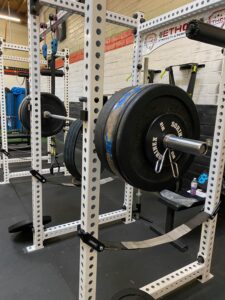
Besides the main elements of the movement – How to actually perform the squat; here are a couple of other things to consider.
- Warm up and stretch adequately. Before your squat session, take time to warm up with dynamic exercises and stretching to increase blood flow, prepare your muscles, and enhance your flexibility. This can help prevent injuries and improve your squat performance.
- Check for obstructions in your workout area (AKA look around before you squat.) Don’t squat too close to a fan, cords, or stuff on the floor.
- Think ahead for if you fail the rep. Use safeties or have an area around you that is safe to dump the bar without smashing up stuff or people.
- Squat to depth. Yeah, it’s a form thing but don’t jump weight if you are squatting high.
- Pay attention to breathing and bracing. Proper breathing and bracing techniques can significantly impact your squat stability and performance. Inhale deeply, filling your diaphragm, and brace your core before descending into the squat. Exhale as you stand back up. This will help keep your spine stable and support your overall lifting form.
- Similar to above. Don’t move up in weight if your form is not solid. If the bar is wobbling around on your back – your form is not solid. Monitor your progress and adjust accordingly. Keep track of your squat weights, reps, and sets to ensure consistent progress. If you encounter plateaus or setbacks, reevaluate your training program and make necessary adjustments to continue making gains.
Need help with form? DM me or talk to a coach.
- Use intelligent plate loading — yes this is probably a debate topic. After loading a 15 and a 10, consider swapping for a 25. Or instead of loading 3 plates — use 45’s etc. Load from heavy plate on the inside to the lightest plates on the outside.
- Don’t neglect mobility work. Incorporating regular mobility exercises targeting your hips, ankles, and thoracic spine can greatly improve your squat depth and form. A well-rounded mobility routine will enhance your overall movement quality and reduce the risk of injury.
- Rest and recover. Giving your body sufficient time to rest and recover between squat sessions is crucial for optimal performance and injury prevention. Make sure to listen to your body and avoid overtraining. Incorporate active recovery activities, such as yoga, foam rolling, or light cardio, to promote better muscle recovery.
